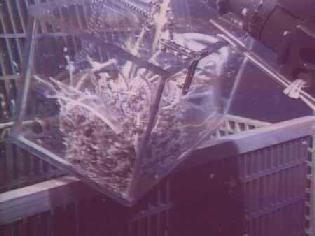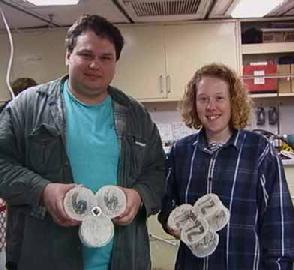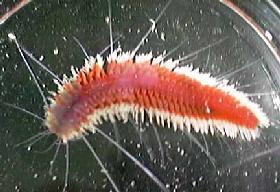WHAT'S NEW:
BACKGROUND:
Mission
Project Description
Cruise Plans:
Participants
Technology (ROV, ships, etc.)
Future Plans
Results:
1998 NeMO Cruise
Axial 1998 "Eruption"
Logbook
June 30, 1999
June 30, 1999
Contents:
- News from Thompson
- Participant Perspective
- Logbook from Teacher at Sea
- Question/Answer from shore to sea
Thompson Science Report
Science Report - Wednesday, June 30
Ships Location: 45 56.3/129 59.1
 Biobox being transferred to the elevator to bring the samples up to the ship. (Dive 491, 1999) |
Listing of all Science News postings
Life at Sea: Participant Perspective
Craig Moyer and
Karen Lynch
Western Washington University
 Hello and welcome to NeMO99! My name is Craig Moyer.
I am an assistant professor at Western Washington University, where I
am a member of the biology department. My specialty is molecular microbial
ecology of hydrothermal vent habitats. You may wonder what exactly
is it that a molecular microbial ecologist does (I know I do . . . often).
Well, because most prokaryotes (Bacteria and Archaea) look alike, I use
bio-molecules like ribosomal DNA as name tags to help identify the different
kinds of microbes that like to live at hydrothermal vents like the
ones here at Axial Volcano. These bio-molecules not only work just like
the bar codes that get scanned at the grocery store, but they also store
information regarding who is most related to whom. Therefore, my job
is basically that of a microbe census-taker and genealogist. In addition,
I try to understand he ecology the hydrothermal system by examining how
the structure of the microbial community relates to the different types
of chemistry we see at the vents. If that weren't enough, I also attempt
to keep track of how these microbial communities change across space (across
a single vent, from one end of the vent site to the other, or even from
one geographical region to another) and over time (from days to months
to years).
Hello and welcome to NeMO99! My name is Craig Moyer.
I am an assistant professor at Western Washington University, where I
am a member of the biology department. My specialty is molecular microbial
ecology of hydrothermal vent habitats. You may wonder what exactly
is it that a molecular microbial ecologist does (I know I do . . . often).
Well, because most prokaryotes (Bacteria and Archaea) look alike, I use
bio-molecules like ribosomal DNA as name tags to help identify the different
kinds of microbes that like to live at hydrothermal vents like the
ones here at Axial Volcano. These bio-molecules not only work just like
the bar codes that get scanned at the grocery store, but they also store
information regarding who is most related to whom. Therefore, my job
is basically that of a microbe census-taker and genealogist. In addition,
I try to understand he ecology the hydrothermal system by examining how
the structure of the microbial community relates to the different types
of chemistry we see at the vents. If that weren't enough, I also attempt
to keep track of how these microbial communities change across space (across
a single vent, from one end of the vent site to the other, or even from
one geographical region to another) and over time (from days to months
to years).
Hydrothermal vents are a great place to study the structure and diversity of microbes because many scientists now think that these habitats are where life began almost 4 billion years ago. This means that studying vent microbes is like looking at organisms that have been around for a long time and therefore have been very successful; like studying the Coelacanth if you are interested in fish. Since hydrothermal vents are considered extreme environments, this tends to keep the overall numbers of different types of microbes lower in any single habitat or location than what you would find someplace more mild like forest soil, which has on the order of 10,000 to 100,000 different kinds of microbes per gram! This makes my job a little easier.
In order to sample the microbial communities, myself and my grad student Karen Lynch employ a couple of different approaches. First, we use an underwater device attached to ROPOS called the slurp-gun to vacuum up microbial mats and capture them in sample jars (photo left, NeMO 1998). Second, we use bacteria traps which we leave in place for a set amount of time, allowing the colonization of microbes as the vent effluent passes through a cylinder covered with a fine mesh with glass wool inside. The bacteria are what we call substrate-limited, so we give them a place (in this case glass wool made of inert silica as a substrate) to attach as the hot vent water passes through. The mesh is to keep the bigger animals like tube worms, palm worms and scale worms from eating up all of our samples. Basically, we provide the microbes with a refuge and happy place for them to grow. Upon recovery of these samples, we then preserve them for later molecular biological analysis.
In addition to studying microbial communities, I am also interested in culturing as we microbiologists call it, the more significant members from within the community. This means trying to get the individual types of microbes which are the major players to grow in the laboratory. This isn't always an easy task, as many if not most microbes have been found to be unculturable. That doesn't stop us from trying new ways to make them happy. Together with my colleague David Emerson at the American Type Culture Collection, we discovered a novel way to culture a new kind of iron-oxidizing bacteria that is able to live completely off the energy from the oxidation of iron (similar to the formation of rust) without requiring a lot of acid around to do it. We have found that this type of bacteria is a major component in many hydrothermal vent systems, and hope to find it here at Axial Volcano as well.
I've been studying the diversity and structure of microbial communities for nearly 9 years now with much of my work happening at places like Loihi, an undersea volcano in Hawaii, or the Guaymas Basin in Mexico. I have been a part of many dive programs with over 90 dives using submersibles and tethered-vehicles, and during this time I have not seen such an amazingly productive tool as ROPOS. It is truly an undersea platform for the future. As I'm sure you an tell from looking at the series of homepages from the NeMO 99 expedition to Axial Volcano, there are many scientists out here with many different projects and interests, and ROPOS has come through like a champ allowing us all to have a wonderful window into the hydrothermal world below. Kudos to the ROPOS team for keeping us in the water!
Karen Lynch
My name is Karen Lynch and I am a graduate student in Biology at Western Washington University. My thesis project includes examining the microbial community structure and diversity found at Axial Seamount, and then to determine the phylogeny (where the different types of microbes are located on the Tree of Life) of these unusual bugs. This is accomplished with the extraction of DNA from microbial samples, and then examination of PCR copied DNA fragments using molecular techniques such as ARDRA or amplified ribosomal DNA restriction analysis. This approach allows me to estimate the abundance of different microbial populations within a sampled community.I have begun my research with samples collected from last year's NeMO 98 cruise. On this year's cruise, I am collecting a new set of samples from the same sites as last year with the hope of comparing the community structure and diversity on a temporal basis. Once these new samples are brought back to the ship, I then, with the help of my advisor, Craig Moyer, fast freeze the samples with liquid nitrogen and dry ice once they have been concentrated. In addition, we process subsamples with fixatives and cryopreservants for microscopic analysis and culturing. I also participate in a watch from midnight to 4am whenever the sub is in the water, where I am responsible for logging all the samples collected and taking frame-grabs off the video feed. Since this is my first research cruise, I wasn't quite sure what to expect. However, it's been an enjoyable eye-opening experience (once I got my sea legs), one in which I wish to repeat if the opportunity arises.
Listing of all Perspectives postings
Teacher At Sea Logbook
Teacher Log #10 6/30/99
With the sunshine peaking through the clouds and a good breeze (18-22 knots) blowing through the air, the spirits aboard the Thompson are soaring. ROPOS is in the middle of one of the most complicated dives planned for it. It is amazing the things it can be used for and how we have come to depend on it. It has visited over 8 vent sites within the last 24 hours and carried out each of its tasks with little trouble. The "Magnificent 7" of the ROPOS crew have got it humming happily along the bottom.
 A new species of scaleworm under the microscope aboard the Thompson. (collected 1999, ROPOS). |
Another of ROPOSs tasks today is collecting high resolution bathymetry over the 1998 lava flow, extending the survey made last year. The ROV is "flown" about 10 m above the bottom while a pencil-beam sonar sweeps from side to side measuring the distance to the sea floor. Holding a steady course, ROPOS drives down a number of parallel lines (sort of like mowing a lawn). The resolution is excellent, less than 1 m of the actual sea floor topography. Measuring the depth (bathymetry) using this method is far more accurate then doing so from a ship at the surface. Mapping this area accurately is just another in the many ways scientist hope to understand what geological processes have occurred here. It also allows scientists to set a new baseline from which future changes can be measured.
 At the present
time, ROPOS is into its 24th hour of diving and is scheduled to continue
through the night. The limiting factor for the dive is usually the number
of samples that can be collected. Once all of the sample containers are
full, its time to head back to the surface, collect the samples and prepare
for the next dive. One way of recovering larger instruments and samples
is by using the "elevator".(photo right) The elevator is basically a big
metal basket that can be used to hold equipment and samples and can be
released from the bottom and retrieved at the surface. Once at the surface
a smaller boat is sent out to retrieve the elevator. Right now, the elevator
is loaded with last years recovered equipment and biological
samples, and scientists are anxious to get it back. The plan was to
retrieve the elevator tonight, but the seas were a little too choppy and
this creates the risk of losing the precious cargo inside, so it was decided
to wait until morning and hope for calmer seas.
At the present
time, ROPOS is into its 24th hour of diving and is scheduled to continue
through the night. The limiting factor for the dive is usually the number
of samples that can be collected. Once all of the sample containers are
full, its time to head back to the surface, collect the samples and prepare
for the next dive. One way of recovering larger instruments and samples
is by using the "elevator".(photo right) The elevator is basically a big
metal basket that can be used to hold equipment and samples and can be
released from the bottom and retrieved at the surface. Once at the surface
a smaller boat is sent out to retrieve the elevator. Right now, the elevator
is loaded with last years recovered equipment and biological
samples, and scientists are anxious to get it back. The plan was to
retrieve the elevator tonight, but the seas were a little too choppy and
this creates the risk of losing the precious cargo inside, so it was decided
to wait until morning and hope for calmer seas.
So, hope for good weather and wish us luck.
Bye for now.
Logbook of all Teacher At Sea postings
Questions & Answers
(oar.pmel.vents.webmaster@noaa.gov)